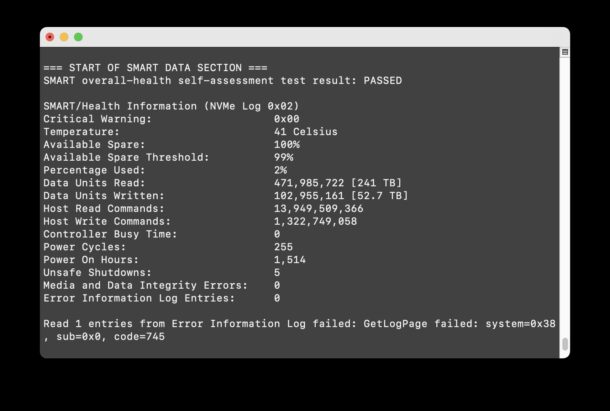How to Check Disk Health on Mac with smartctl

There are various ways to check the health of a hard disk drive (HDD) and solid state drive (SSD) that is used on a Mac with drives that support SMART, which stands for Self-Monitoring Analysis Reporting Technology. These options range from fairly simple using Disk Utility to check the SMART status of a drive, to much more complex with third party tools like DriveDX.
We’re going to introduce another excellent option for Mac users to monitor and analyze the health of their storage devices, using a command line tool called “smartctl”.
The smartctl utility will check SMART status self-assessments of drive health, provide the temperature of internal drives, as well as offer read and write information (which is relevant particularly for SSDs), and general drive health analysis.
How to Use smartctl to Check Mac Drive Health
To get started with smartctl, you need to install it with HomeBrew first. Yes that means you’ll want to install Homebrew if you haven’t done so already (here are instructions for macOS Sonoma, Ventura, and later).
Open the Terminal application if you have not done so already to begin.
First, install smartctl:
brew install smartmontools
After Homebrew completes the installation of the smartctl package, you are ready to use the utility to display information about your disk device and drive health:
smartctl -a disk0
(Replace disk0 with disk1, disk2, etc if you have multiple drives and want to check those instead)
You’ll get a report back in the command line that may read something like the following:
% sudo smartctl -a disk0
smartctl 7.4 2023-08-01 r5530 [Darwin 23.4.0 arm64] (local build)
Copyright (C) 2002-23, Bruce Allen, Christian Franke, www.smartmontools.org
=== START OF INFORMATION SECTION ===
Model Number: APPLE SSD AP1024Z
Serial Number: 0ea8r31b280003
Firmware Version: 373.100.
PCI Vendor/Subsystem ID: 0x106b
IEEE OUI Identifier: 0x000000
Controller ID: 0
NVMe Version: 1.2
Number of Namespaces: 3
Local Time is: Wed Apr 10 01:11:24 2024 PDT
Firmware Updates (0x02): 1 Slot
Optional Admin Commands (0x0004): Frmw_DL
Optional NVM Commands (0x0004): DS_Mngmt
Maximum Data Transfer Size: 256 Pages
Supported Power States
St Op Max Active Idle RL RT WL WT Ent_Lat Ex_Lat
0 + 0.00W - - 0 0 0 0 0 0
=== START OF SMART DATA SECTION ===
SMART overall-health self-assessment test result: PASSED
SMART/Health Information (NVMe Log 0x02)
Critical Warning: 0x00
Temperature: 41 Celsius
Available Spare: 100%
Available Spare Threshold: 99%
Percentage Used: 2%
Data Units Read: 471,985,722 [241 TB]
Data Units Written: 102,955,161 [52.7 TB]
Host Read Commands: 13,949,509,366
Host Write Commands: 1,322,749,058
Controller Busy Time: 0
Power Cycles: 255
Power On Hours: 1,514
Unsafe Shutdowns: 5
Media and Data Integrity Errors: 0
Error Information Log Entries: 0
Read 1 entries from Error Information Log failed: GetLogPage failed: system=0x38, sub=0x0, code=745
As you can see, a lot of helpful and revealing information is provided by smartctl, including temperature, disk read/write info, unsafe shutdowns (crashes or power situations), power cycles, hours of the drive on, and much more.
One section you will particularly want to pay attention to when checking drive health is the “SMART overall-health self-assessment test result” section, which you will want to say PASSED. If that says FAILED, you will want to backup your data right away, because the disk may soon fail, which could result in catastrophic data loss.
Whatever the case, whether the drive is healthy or not, and passes SMART checks or not, make it a habit to setup Time Machine and routinely backup your Mac. Backing up your computer is one of the most important things you can do, because without backups, if there’s a catastrophic drive failure, damage to the computer, loss, or theft, your data is gone too. Don’t be in that situation, think of backups like an insurance policy – well worth the premium!
Do you use smartctl or any other SMART monitoring tools to check the health of your disk drive? What do you think of these features? Let us know in the comments.


Thanks for the tip. And how do you proceed with Fusion Drive?
does not work for attached USB drives
No need for homebrew, smartmontools pkg https://sourceforge.net/projects/smartmontools/
Reference https://www.smartmontools.org/wiki/Download#InstalltheOSXDarwinpackage